Mybatis学习笔记
# 简介
什么是Mybatis
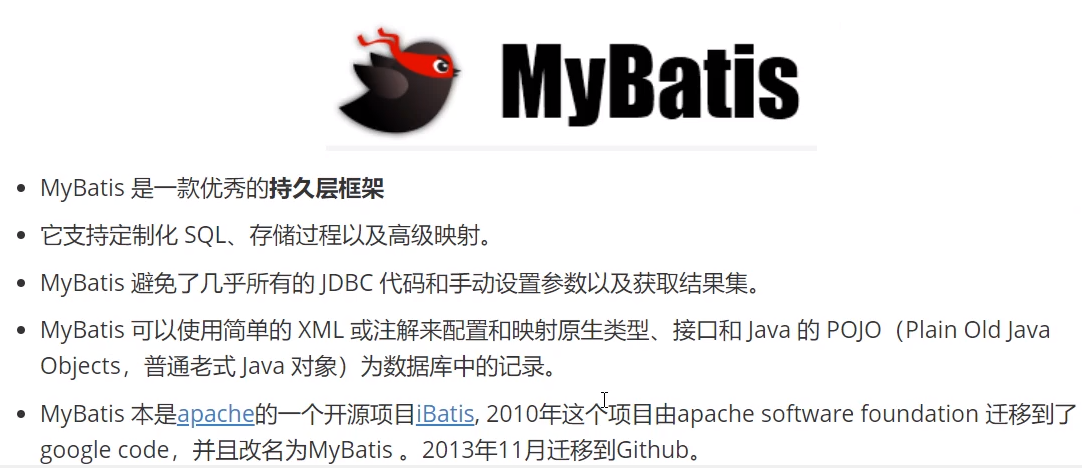
maven仓库
<!-- https://mvnrepository.com/artifact/org.mybatis/mybatis -->
<dependency>
<groupId>org.mybatis</groupId>
<artifactId>mybatis</artifactId>
<version>3.5.7</version>
</dependency>
Github:https://hub.fastgit.org/mybatis/mybatis-3
持久化
数据持久化
将程序的数据在持久状态和瞬时状态转化的过程
内存:断电即失
数据库jdbc io文件持久化
持久层
Dao层,Service层,Controller层...
完成持久化工作的代码块
层界限十分明显
模块项目创建过程
搭建环境
1.创建数据库
2.新建maven项目
3.删除src目录,导入maven依赖
1 <dependencies>
2 <!-- Mysql驱动 -->
3 <dependency>
4 <groupId>mysql</groupId>
5 <artifactId>mysql-connector-java</artifactId>
6 <version>5.1.47</version>
7 </dependency>
8 <!-- Mybatis -->
9 <!-- https://mvnrepository.com/artifact/org.mybatis/mybatis -->
10 <dependency>
11 <groupId>org.mybatis</groupId>
12 <artifactId>mybatis</artifactId>
13 <version>3.5.7</version>
14 </dependency>
15 <!-- junit -->
16 <dependency>
17 <groupId>junit</groupId>
18 <artifactId>junit</artifactId>
19 <version>4.12</version>
20 </dependency>
21 </dependencies>
创建模块
编写Mybatis核心配置文件
1 <?xml version="1.0" encoding="UTF-8" ?>
2 <!DOCTYPE configuration
3 PUBLIC "-//mybatis.org//DTD Config 3.0//EN"
4 "http://mybatis.org/dtd/mybatis-3-config.dtd">
5 <!--核心配置文件-->
6 <configuration>
7
8 <environments default="development">
9 <environment id="development">
10 <transactionManager type="JDBC"/>
11 <dataSource type="POOLED">
12 <property name="driver" value="com.mysql.jdbc.Driver"/>
13 <property name="url" value="jdbc:mysql://localhost:3306/mybatis?useSSL=true&useUnicode=true&characterEncoding=UTF-8"/>
14 <property name="username" value="root"/>
15 <property name="password" value="123456"/>
16 </dataSource>
17 </environment>
18 </environments>
19
20 </configuration>
编写Mybatis工具类
1 //sqlSessionFactory--->sqlSession
2 public class MybatisUtils {
3 public static SqlSessionFactory sqlSessionFactory ;
4 static {
5 try {
6 //使用Mybatis第一步 获取sqlSessionFactory对象
7 String resource = "mybatis-config.xml";
8 InputStream inputStream = Resources.getResourceAsStream(resource);
9 sqlSessionFactory = new SqlSessionFactoryBuilder().build(inputStream);
10 } catch (IOException e) {
11 e.printStackTrace();
12 }
13
14 }
15 //既然有了 SqlSessionFactory,顾名思义,我们可以从中获得 SqlSession 的实例。
16 // SqlSession 提供了在数据库执行 SQL 命令所需的所有方法。
17 public static SqlSession getSqlSession(){
18 return sqlSessionFactory.openSession();
19 }
20 }
编写代码
实体类
1 package com.kuang.pojo;
2 //实体类
3 public class User {
4 private int id;
5 public String name;
6 public String pwd;
7
8 public User(int id, String name, String pwd) {
9 this.id = id;
10 this.name = name;
11 this.pwd = pwd;
12 }
13
14 public User() {
15 }
16
17 public int getId() {
18 return id;
19 }
20
21 public void setId(int id) {
22 this.id = id;
23 }
24
25 public String getName() {
26 return name;
27 }
28
29 public void setName(String name) {
30 this.name = name;
31 }
32
33 public String getPwd() {
34 return pwd;
35 }
36
37 public void setPwd(String pwd) {
38 this.pwd = pwd;
39 }
40
41 @Override
42 public String toString() {
43 return "User{" +
44 "id=" + id +
45 ", name='" + name + '\'' +
46 ", pwd='" + pwd + '\'' +
47 '}';
48 }
49 }
Dao接口
1 public interface UserDao {
2 List<User> getUserList();
3 }
接口实现类(由原理UserDaoImpl转换为一个Mapper配置文件)
1 <?xml version="1.0" encoding="UTF-8" ?>
2 <!DOCTYPE mapper
3 PUBLIC "-//mybatis.org//DTD Mapper 3.0//EN"
4 "http://mybatis.org/dtd/mybatis-3-mapper.dtd">
5 <!--namespace=绑定一个对应的Dao/Mappe接口-->
6 <mapper namespace="com.kuang.dao.UserDao">
7 <select id="getUserList" resultType="com.kuang.pojo.User">
8 select * from mybatis.uers
9 </select>
10
11 </mapper>
测试
注意点:org.apache.ibatis.binding.BindingException: Type interface com.kuang.dao.UserDao is not known to the MapperRegistry.
类型接口Dao是未知的在MapperRegistry中
<!--每个Mapper.XML都需要在Mybatis核心配置文件中注册-->
Maven导出资源 pom打包文件
1
2 <build>
3 <finalName>test</finalName>
4 <resources>
5 <resource>
6 <directory>src/main/resources</directory>
7 <includes>
8 <include>**/*.properties</include>
9 <include>**/*.xml</include>
10 <include>**/*.tld</include>
11 </includes>
12 <filtering>false</filtering>
13 </resource>
14 <resource>
15 <directory>src/main/java</directory>
16 <includes>
17 <include>**/*.properties</include>
18 <include>**/*.xml</include>
19 <include>**/*.tld</include>
20 </includes>
21 <filtering>false</filtering>
22 </resource>
23 </resources>
24 </build>
junit测试
@Test
public void test(){
//第一步获得SqlSession对象
SqlSession sqlSession = MybatisUtils.getSqlSession();
//执行SQL 方式1:getMapper
UserDao userDao = sqlSession.getMapper(UserDao.class);
List<User> userList = userDao.getUserList();
for (User user : userList) {
System.out.println(user);
}
//关闭SqlSession
sqlSession.close();
}

CRUD的实现及问题
注意事项:namespace中的包名要和Dao/mapper接口的包名一致
Select
查询语句
id:对应的namespace中的方法名;
resultType:sql语句执行的返回值!
parameterType:参数类型
1.编写接口
2.编写对应的mapper中的sql语句
3.测试
1 public interface UserMapper {
2 //查询全部用户
3 List<User> getUserList();
4
5 //根据id查询用户
6 User getUserById(int id);
7
8 //insert一个用户
9 int addUser(User user);
10
11 //update一个用户
12 int updateUser(User user);
13
14 //delete用户
15 int deleteUser(int id);
16 }
1 mapper namespace="com.kuang.dao.UserMapper">
2 <select id="getUserList" resultType="com.kuang.pojo.User">
3 select * from mybatis.user
4 </select>
5
6 <select id="getUserById" resultType="com.kuang.pojo.User" parameterType="int">
7 select * from mybatis.user where id = #{id};
8 </select>
9
10 <insert id="addUser" parameterType="com.kuang.pojo.User">
11 insert into mybatis.user(id,name,pwd)value (#{id},#{name},#{pwd});
12 </insert>
13
14 <update id="updateUser" parameterType="com.kuang.pojo.User">
15 update mybatis.user set name =#{name},pwd=#{pwd} where id=#{id};
16 </update>
17
18 <delete id="deleteUser" parameterType="int">
19 delete from mybatis.user where id =#{id};
20 </delete>
21 </mapper>
test
1 @Test
2 public void test(){
3 //第一步获得SqlSession对象
4 SqlSession sqlSession = MybatisUtils.getSqlSession();
5 //执行SQL 方式1:getMapper
6 UserMapper userMapper = sqlSession.getMapper(UserMapper.class);
7 List<User> userList = userMapper.getUserList();
8 for (User user : userList) {
9 System.out.println(user);
10 }
11 //关闭SqlSession
12 sqlSession.close();
13 }
14
15 @Test
16 public void getUserById(){
17 SqlSession sqlSession = MybatisUtils.getSqlSession();
18
19 UserMapper mapper = sqlSession.getMapper(UserMapper.class);
20 User user = mapper.getUserById(1);
21 System.out.println(user);
22
23 sqlSession.close();
24 }
25 //增删改需要提交事务
26 @Test
27 public void addUser(){
28 SqlSession sqlSession = MybatisUtils.getSqlSession();
29
30 UserMapper mapper = sqlSession.getMapper(UserMapper.class);
31 mapper.addUser(new User(5,"小明","1562344"));
32 sqlSession.commit();
33 sqlSession.close();
34 }
35 @Test
36 public void updateUser(){
37 SqlSession sqlSession = MybatisUtils.getSqlSession();
38
39 UserMapper mapper = sqlSession.getMapper(UserMapper.class);
40 mapper.updateUser(new User(4,"小蓝","6554332"));
41 sqlSession.commit();
42 sqlSession.close();
43 }
44 @Test
45 public void deleteUser(){
46 SqlSession sqlSession = MybatisUtils.getSqlSession();
47 UserMapper mapper = sqlSession.getMapper(UserMapper.class);
48 mapper.deleteUser(4);
49 sqlSession.commit();
50 sqlSession.close();
51 }
相关问题:
增删改要提交事务
java.lang.ExceptionInInitializerErrorCreate breakpoint
at com.kuang.dao.UserDaoTest.updateUser(UserDaoTest.java:48)
Caused by: org.apache.ibatis.exceptions.PersistenceException:
### Error building SqlSession.
### The error may exist in com/kuang/dao/UserMapper.xml
找不到‘id’ 原因为在下面这段代码中将parameterType="int"写成了parameterType="id" 从而没找到id这个参数
<delete id="deleteUser" parameterType="int">
Map和SQL模糊查询实现问题
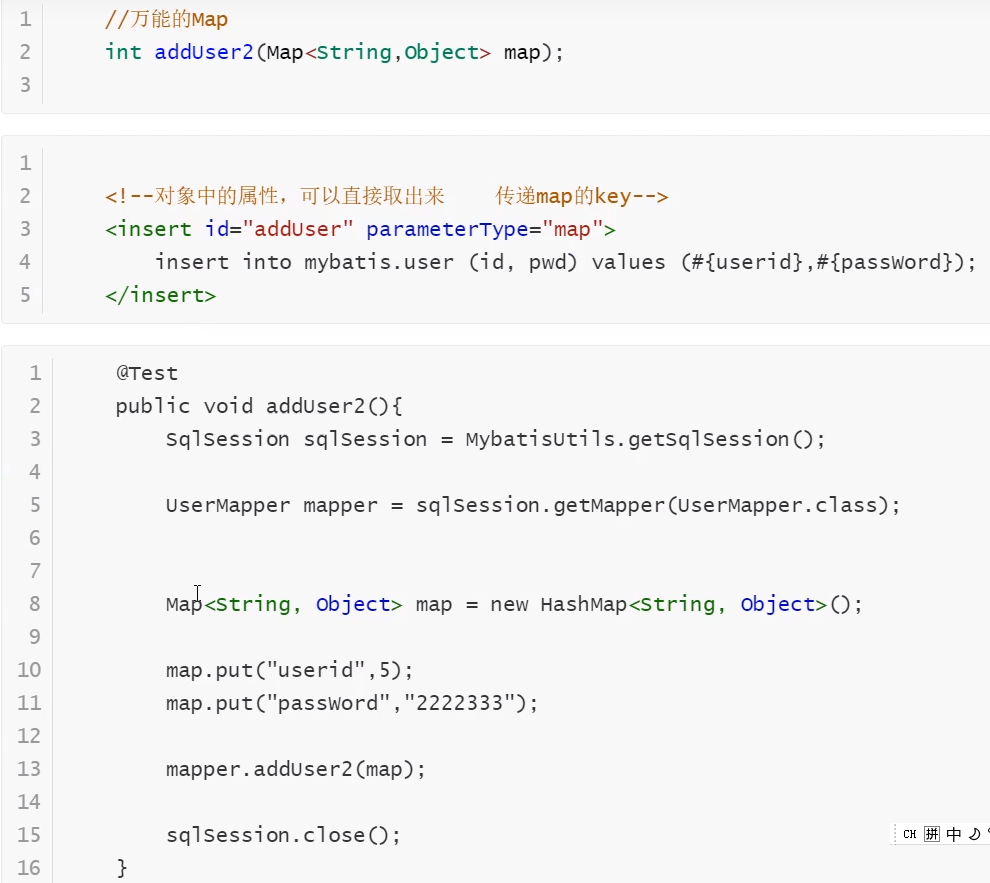

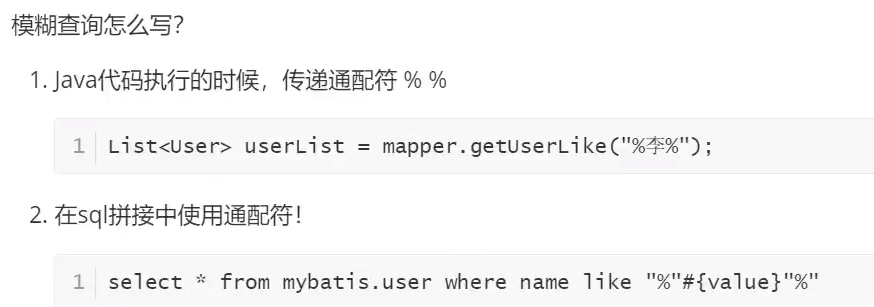
配置解析
mybatis核心配置文件
mybatis-config.xml
configuration(配置)
properties(属性)
settings(设置)
typeAliases(类型别名)
typeHandlers(类型处理器)
objectFactory(对象工厂)
plugins(插件)
nvironments(环境配置)
environment(环境变量)
transactionManager(事务管理器)
dataSource(数据源)
databaseIdProvider(数据库厂商标识)
mappers(映射器)
环境配置(properties)
MyBatis 可以配置成适应多种环境
不过要记住:尽管可以配置多个环境,但每个 SqlSessionFactory 实例只能选择一种环境。
Mybatis 默认的事务管理器是JDBC,连接池:POOLED
属性优化
我们可以通过properties属性来引用配置文件
这些属性可以在外部进行配置,并可以进行动态替换。你既可以在典型的 Java 属性文件中配置这些属性,也可以在 properties 元素的子元素中设置。 (db.properties)
编写一个配置文件
db.properties
driver = com.mysql.jdbc.Driver
url = jdbc:mysql://localhost:3306/mybatis?useSSL=false&useUnicode=true&characterEncoding=UTF-8
username=root
password=123456
在核心配置文件中引入
mybatis-config.xml (同时有的话,优先走外面properties)
<?xml version="1.0" encoding="UTF-8" ?>
<!DOCTYPE configuration
PUBLIC "-//mybatis.org//DTD Config 3.0//EN"
"http://mybatis.org/dtd/mybatis-3-config.dtd">
<configuration>
<!--引入外部配置文件-->
<!--<properties resource="db.properties"/>-->
<properties resource="db.properties">
<property name="username" value="root"></property>
<property name="password" value="123456"></property>
</properties>
<environments default="development">
<environment id="development">
<transactionManager type="JDBC"/>
<dataSource type="POOLED">
<property name="driver" value="${driver}"/>
<property name="url" value="${url}"/>
<property name="username" value="${username}"/>
<property name="password" value="${password}"/>
</dataSource>
</environment>
</environments>
<!--每一个mapper.xml都需要注册-->
<mappers>
<mapper resource="com/hou/dao/UserMapper.xml"/>
</mappers>
</configuration>
别名优化
类型别名可为 Java 类型设置一个缩写名字。
<typeAliases>
<typeAlias type="com.kuang.pojo.User" alias="User"></typeAlias>
</typeAliases>
扫描实体类的包,默认别名就为这个类的类名首字母小写
<typeAliases>
<package name="com.kuang.pojo"></package>
</typeAliases>
在实体类,比较少的时候使用第一种,实体类多使用第二种。
第一种可以自定义,第二则不行,但是 若有注解,则别名为其注解值 。
@Alias("hello")
public class User {
}
映射器说明
- 设置
| 设置名 | 描述 | 有效值 | 默认值 |
|---|---|---|---|
| cacheEnabled | 全局性地开启或关闭所有映射器配置文件中已配置的任何缓存。 | true | false | true |
| lazyLoadingEnabled | 延迟加载的全局开关。当开启时,所有关联对象都会延迟加载。 特定关联关系中可通过设置 fetchType 属性来覆盖该项的开关状态。 |
true | false | false |
| logImpl | 指定 MyBatis 所用日志的具体实现,未指定时将自动查找。 | SLF4J | LOG4J | LOG4J2 | JDK_LOGGING | COMMONS_LOGGING | STDOUT_LOGGING | NO_LOGGING | 未设置 |
其他
- typeHandlers(类型处理器)
- objectFactory(对象工厂)
- plugins(插件)
- mybatis-generator-core
- mybatis-plus
- 通用mapper
映射器
方式一: [推荐使用]
<mappers>
<mapper resource="com/kuang/dao/UserMapper.xml"/>
</mappers>
方式二:
<mappers>
<mapper class="com.kuang.dao.UserMapper" />
</mappers>
- 接口和它的Mapper必须同名
- 接口和他的Mapper必须在同一包下
方式三:
<mappers>
<!--<mapper resource="com/kuang/dao/UserMapper.xml"/>-->
<!--<mapper class="com.kuang.dao.UserMapper" />-->
<package name="com.kuang.dao" />
</mappers>
- 接口和它的Mapper必须同名
- 接口和他的Mapper必须在同一包下
生命周期和作用域
作用域和生命周期类别是至关重要的,因为错误的使用会导致非常严重的并发问题。
SqlSessionFactoryBuilder:
- 一旦创建了 SqlSessionFactory,就不再需要它了 。
- 局部变量
SqlSessionFactory:
- 就是数据库连接池。
- 一旦被创建就应该在应用的运行期间一直存在 ,没有任何理由丢弃它或重新创建另一个实例 。 多次重建 SqlSessionFactory 被视为一种代码“坏习惯”。
- 因此 SqlSessionFactory 的最佳作用域是应用作用域。
- 最简单的就是使用单例模式或者静态单例模式。
SqlSession:
- 每个线程都应该有它自己的 SqlSession 实例。
- 连接到连接池的请求!
- SqlSession 的实例不是线程安全的,因此是不能被共享的 ,所以它的最佳的作用域是请求或方法作用域。
- 用完之后赶紧关闭,否则资源被占用。
解决属性名和字段名不一致的问题
数据库中的字段
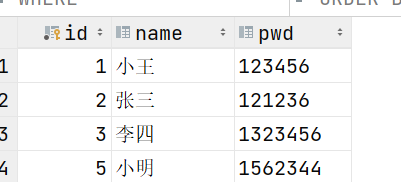
新建一个项目,拷贝之前,测试实体字段不一致的情况
User
package com.kuang.pogo;
public class User {
private int id;
private String name;
private String password;
}
问题:

解决方法:
核心配置文件
- 起别名
<select id="getUserById" resultType="User"
parameterType="int">
select id,name,pwd as password from mybatis.user where id = #{id}
</select>
- resultMap 结果集映射
<?xml version="1.0" encoding="UTF-8" ?>
<!DOCTYPE mapper
PUBLIC "-//mybatis.org//DTD Mapper 3.0//EN"
"http://mybatis.org/dtd/mybatis-3-mapper.dtd">
<!--namespace绑定一个对应的mapper接口-->
<mapper namespace="com.hou.dao.UserMapper">
<select id="getUserById" resultMap="UserMap" parameterType="int">
select * from mybatis.user where id = #{id}
</select>
<!--结果集映射-->
</mapper>
resultMap元素是 MyBatis 中最重要最强大的元素。- ResultMap 的设计思想是,对简单的语句无需配置,对于复杂一点的语句,只需要描述语句之间的关系就行了。
- 如果世界都那么简单就好了
<resultMap id="UserMap" type="User">
<!--colunm 数据库中的字段,property实体中的属性-->
<!--<result column="id" property="id"></result>-->
<!--<result column="name" property="name"></result>-->
<result column="pwd" property="password"></result>
</resultMap>
日志
1. 日志工厂
如果一个数据库操作出现了异常,我们需要排错。日志就是最好的助手。
曾经:sout,debug
现在:日志工厂
logImpl
- SLF4J
- LOG4J [掌握]
- LOG4J2
- JDK_LOGGING
- COMMONS_LOGGING
- STDOUT_LOGGING [掌握]
- NO_LOGGING
具体使用哪一个,在设置中设定
STDOUT_LOGGING 标志日志输出
mybatis-confi中
<settings>
<setting name="logImpl" value="STDOUT_LOGGING"/>
</settings>
2. Log4j
-
先导包
pom.xml下
<dependencies> <!-- https://mvnrepository.com/artifact/log4j/log4j --> <dependency> <groupId>log4j</groupId> <artifactId>log4j</artifactId> <version>1.2.17</version> </dependency> </dependencies> -
新建log4j.properties文件
### set log levels ###
log4j.rootLogger = DEBUG,console,file
### 输出到控制台 ###
log4j.appender.console = org.apache.log4j.ConsoleAppender
log4j.appender.console.Target = System.out
log4j.appender.console.Threshold = DEBUG
log4j.appender.console.layout = org.apache.log4j.PatternLayout
log4j.appender.console.layout.ConversionPattern = [%c]-%m%n
### 输出到日志文件 ###
log4j.appender.file=org.apache.log4j.RollingFileAppender
log4j.appender.file.File=./log/hou.log
log4j.appender.file.MaxFileSize=10mb
log4j.appender.file.Threshold=DEBUG
log4j.appender.file.layout=org.apache.log4j.PatternLayout
log4j.appender.file.layout.ConversionPattern=[%p][%d{yy-MM-dd}][%c]%m%n
# 日志输出级别
log4j.logger.org.mybatis=DEBUG
log4j.logger.java.sql=DEBUG
log4j.logger.java.sql.Statement=DEBUG
log4j.logger.java.sql.ResultSet=DEBUG
log4j.logger.java.sql.PreparedStatement=DEBUG
- 配置实现
<settings>
<setting name="logImpl" value="LOG4J"/>
</settings>
- Log4j使用
分页
1. Limit 分页
语法:
SELECT * from user limit startIndex,pageSize;
SELECT * from user limit 0,2;
package com.hou.dao;
import com.hou.pojo.User;
import java.util.List;
import java.util.Map;
public interface UserMapper {
//根据id查询用户
User getUserById(int id);
List<User> getUserByLimit(Map<String, Integer> map);
}
xml
<?xml version="1.0" encoding="UTF-8" ?>
<!DOCTYPE mapper
PUBLIC "-//mybatis.org//DTD Mapper 3.0//EN"
"http://mybatis.org/dtd/mybatis-3-mapper.dtd">
<!--namespace绑定一个对应的mapper接口-->
<mapper namespace="com.hou.dao.UserMapper">
<select id="getUserById" resultMap="UserMap"
parameterType="int">
select * from mybatis.user where id = #{id}
</select>
<!--结果集映射-->
<resultMap id="UserMap" type="User">
<!--colunm 数据库中的字段,property实体中的属性-->
<!--<result column="id" property="id"></result>-->
<!--<result column="name" property="name"></result>-->
<result column="pwd" property="password"></result>
</resultMap>
<select id="getUserByLimit" parameterType="map"
resultType="User" resultMap="UserMap">
select * from mybatis.user limit #{startIndex},#{pageSize}
</select>
</mapper>
test类
@Test
public void getByLimit(){
SqlSession sqlSession = MybatisUtils.getSqlSession();
UserMapper mapper = sqlSession.getMapper(UserMapper.class);
Map<String, Integer> map = new HashMap<String, Integer>();
map.put("startIndex", 1);
map.put("pageSize", 2);
List<User> userList = mapper.getUserByLimit(map);
for(User user:userList){
System.out.println(user);
}
sqlSession.close();
}
2. RowBounds分页
@Test
@Test
public void getUserByRow(){
SqlSession sqlSession = MybatisUtils.getSqlSession();
//RowBounds实现
RowBounds rowBounds = new RowBounds(1, 2);
//通过java代码层面
List<User> userList = sqlSession.selectList
("com.hou.dao.UserMapper.getUserByRowBounds",
null,rowBounds);
for (User user : userList) {
System.out.println(user);
}
sqlSession.close();
}
3. 分页插件
- pageHelper
使用注解开发
-
删除 UserMapper.xml
-
UserMapper
package com.kuang.dao; import com.kuang.pojo.User; import org.apache.ibatis.annotations.Select; import java.util.List; public interface UserMapper { @Select("select * from user") List<User> getUsers(); } -
核心配置 mybatis-config.xml
<?xml version="1.0" encoding="UTF-8" ?> <!DOCTYPE configuration PUBLIC "-//mybatis.org//DTD Config 3.0//EN" "http://mybatis.org/dtd/mybatis-3-config.dtd"> <configuration> <!--引入外部配置文件--> <properties resource="db.properties"/> <!--可以给实体类起别名--> <typeAliases> <typeAlias type="com.kuang.pojo.User" alias="User"></typeAlias> </typeAliases> <environments default="development"> <environment id="development"> <transactionManager type="JDBC"/> <dataSource type="POOLED"> <property name="driver" value="${driver}"/> <property name="url" value="${url}"/> <property name="username" value="${username}"/> <property name="password" value="${password}"/> </dataSource> </environment> </environments> <!--绑定接口--> <mappers> <mapper class="com.kuang.dao.UserMapper"></mapper> </mappers> </configuration>本质:反射机制
底层:动态代理!
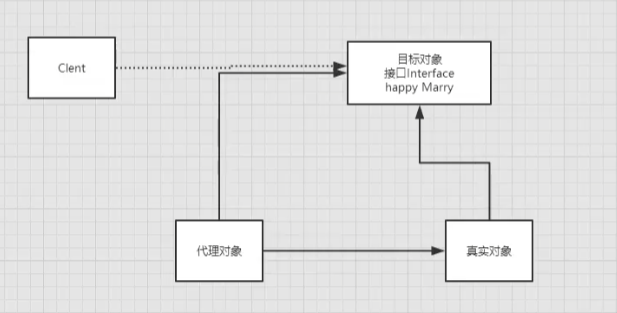
Mybatis详细执行流程:
-
Resource获取全局配置文件
-
实例化SqlsessionFactoryBuilder构造器
-
解析配置文件流XMLCondigBuilder
-
Configration所有的配置信息
-
SqlSessionFactory实例化
-
trasactional事务管理
-
创建executor执行器
-
创建SqlSession
-
实现CRUD
-
查看是否执行成功
-
提交事务
-
关闭
注解CRUD
package com.kuang.dao;
import com.kuang.pojo.User;
import org.apache.ibatis.annotations.*;
import java.util.List;
public interface UserMapper {
@Select("select * from user")
List<User> getUsers();
//方法存在多个参数,所有的参数必须加@Param
@Select("select * from user where id = #{id}")
User getUserById(@Param("id") int id);
@Insert("insert into user (id, name, pwd) values" +
"(#{id},#{name},#{password})")
int addUser(User user);
@Update("update user set name=#{name}, pwd=#{password} " +
"where id=#{id}")
int updateUser(User user);
@Delete("delete from user where id=#{id}")
int deleteUser(@Param("id") int id);
}
MybatisUtile
package com.kuang.utils;
import org.apache.ibatis.io.Resources;
import org.apache.ibatis.session.SqlSession;
import org.apache.ibatis.session.SqlSessionFactory;
import org.apache.ibatis.session.SqlSessionFactoryBuilder;
import java.io.IOException;
import java.io.InputStream;
//sqlSessionFactory --> sqlSession
public class MybatisUtils {
private static SqlSessionFactory sqlSessionFactory;
static {
try {
//使用mybatis第一步:获取sqlSessionFactory对象
String resource = "mybatis-config.xml";
InputStream inputStream = Resources.getResourceAsStream(resource);
sqlSessionFactory = new SqlSessionFactoryBuilder().build(inputStream);
} catch (IOException e) {
e.printStackTrace();
}
}
public static SqlSession getSqlSession(){
//自动提交事务
return sqlSessionFactory.openSession(true);
}
}
Test【需要将接口注册绑定到核心配置文件中】
package com.kuang.dao;
import com.kuang.pojo.User;
import com.kuang.utils.MybatisUtils;
import org.apache.ibatis.session.SqlSession;
import org.junit.Test;
import java.util.List;
public class UserDaoTest {
@Test
public void test(){
// 获得sqlsession对象
SqlSession sqlSession = MybatisUtils.getSqlSession();
try{
// 1.执行 getmapper
UserMapper userDao = sqlSession.getMapper(UserMapper.class);
List<User> userList = userDao.getUsers();
for (User user : userList) {
System.out.println(user);
}
}catch(Exception e){
e.printStackTrace();
}finally{
//关闭
sqlSession.close();
}
}
@Test
public void getuserById(){
// 获得sqlsession对象
SqlSession sqlSession = MybatisUtils.getSqlSession();
try{
// 1.执行 getmapper
UserMapper userDao = sqlSession.getMapper(UserMapper.class);
User user = userDao.getUserById(1);
System.out.println(user);
}catch(Exception e){
e.printStackTrace();
}finally{
//关闭
sqlSession.close();
}
}
@Test
public void addUser(){
// 获得sqlsession对象
SqlSession sqlSession = MybatisUtils.getSqlSession();
try{
// 1.执行 getmapper
UserMapper userDao = sqlSession.getMapper(UserMapper.class);
userDao.addUser(new User(6, "kun","123"));
}catch(Exception e){
e.printStackTrace();
}finally{
//关闭
sqlSession.close();
}
}
@Test
public void updateUser(){
// 获得sqlsession对象
SqlSession sqlSession = MybatisUtils.getSqlSession();
try{
// 1.执行 getmapper
UserMapper userDao = sqlSession.getMapper(UserMapper.class);
userDao.updateUser(new User(6, "fang","123"));
}catch(Exception e){
e.printStackTrace();
}finally{
//关闭
sqlSession.close();
}
}
@Test
public void deleteUser(){
// 获得sqlsession对象
SqlSession sqlSession = MybatisUtils.getSqlSession();
try{
// 1.执行 getmapper
UserMapper userDao = sqlSession.getMapper(UserMapper.class);
userDao.deleteUser(6);
}catch(Exception e){
e.printStackTrace();
}finally{
//关闭
sqlSession.close();
}
}
}
关于@Param()注解
-
基本类型的参数或者String类型,需要加上
-
引用类型不需要加
-
如果只有一个基本类型可以忽略但是建议加上
-
我们在sql中引用的就是我们这里的@Param("")中设定的属性名
#{} ${}区别
Lombok
-
在IDEA中安装lombok插件
-
配置
<dependencies> <!-- https://mvnrepository.com/artifact/org.projectlombok/lombok --> <dependency> <groupId>org.projectlombok</groupId> <artifactId>lombok</artifactId> <version>1.18.12</version> </dependency> </dependencies> -
@Getter and @Setter @FieldNameConstants @ToString @EqualsAndHashCode @AllArgsConstructor, @RequiredArgsConstructor and @NoArgsConstructor @Log, @Log4j, @Log4j2, @Slf4j, @XSlf4j, @CommonsLog, @JBossLog, @Flogger, @CustomLog @Data @Builder @SuperBuilder @Singular @Delegate @Value @Accessors @Wither @With @SneakyThrows@Data: 无参构造,get,set,toString,hashCode
在实体类上加注解
package com.kuang.pojo; import lombok.AllArgsConstructor; import lombok.Data; import lombok.NoArgsConstructor; @Data @AllArgsConstructor @NoArgsConstructor public class User { private int id; private String name; private String password; }
多对一处理
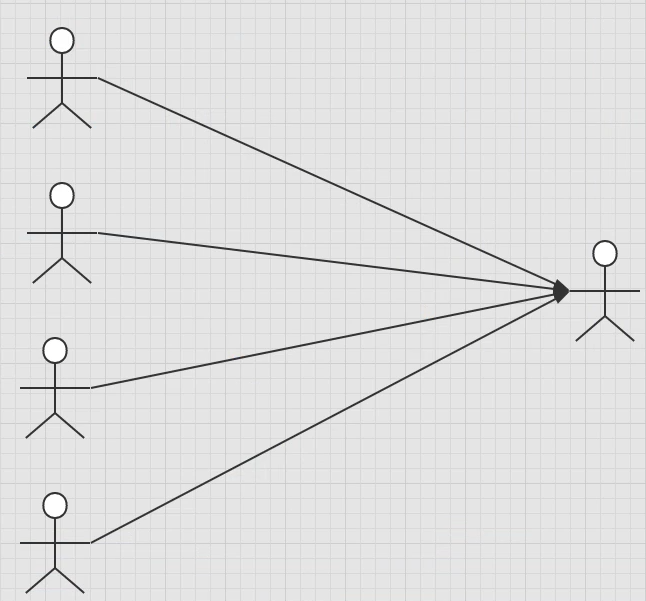
-
多个学生对应一个老师
-
对于学生 关联 多个学生关联一个老师【多对一】
-
对于老师,集合,一个老师有很多学生【一对多】
SQL:
CREATE TABLE `teacher` (
`id` INT(10) NOT NULL,
`name` VARCHAR(30) DEFAULT NULL,
PRIMARY KEY (`id`)
) ENGINE=INNODB DEFAULT CHARSET=utf8
INSERT INTO teacher(`id`, `name`) VALUES ('1', '秦老师');
CREATE TABLE `student` (
`id` INT(10) NOT NULL,
`name` VARCHAR(30) DEFAULT NULL,
`tid` INT(10) DEFAULT NULL,
PRIMARY KEY (`id`),
KEY `fktid` (`tid`),
CONSTRAINT `fktid` FOREIGN KEY (`tid`) REFERENCES `teacher` (`id`)
) ENGINE=INNODB DEFAULT CHARSET=utf8
INSERT INTO `student` (`id`, `name`, `tid`) VALUES ('1', '小明','1');
INSERT INTO `student` (`id`, `name`, `tid`) VALUES ('2', '小红', '1');
INSERT INTO `student` (`id`, `name`, `tid`) VALUES ('3', '小张', '1');
INSERT INTO `student` (`id`, `name`, `tid`) VALUES ('4', '小李', '1');
INSERT INTO `student` (`id`, `name`, `tid`) VALUES ('5', '小王', '1');
测试环境搭建
1.导入lombok
2.新建实体类Teacher,Student
3.建立Mapper接口
4.建立Mapper.XML文件
5.在核心配置文件中绑定注册Mapper接口或者文件
6.测试查询是否能够成功
按照查询嵌套处理
<select id="getStudent" resultMap="StudentTeacher">
select * from mybatis.student
</select>
<resultMap id="StudentTeacher" type="com.kuang.pojo.Student">
<result property="id" column="id"></result>
<result property="name" column="name"></result>
<!--对象使用assiociation-->
<!--集合用collection-->
<association property="teacher" column="tid"
javaType="com.kuang.pojo.Teacher"
select="getTeacher">
</association>
</resultMap>
<select id="getTeacher" resultType="com.kuang.pojo.Teacher">
select * from mybatis.teacher where id = #{id};
</select>
按照结果嵌套处理
<!--===按照结果嵌套处理===-->
<select id="getStudent2" resultMap="StudentTeacher2">
select s.id sid,s.name sname,t.name tname,t.id tid
from mybatis.student s,mybatis.teacher t
where s.tid=t.id;
</select>
<resultMap id="StudentTeacher2" type="com.kuang.pojo.Student">
<result property="id" column="sid"/>
<result property="name" column="sname"/>
<association property="teacher" javaType="com.kuang.pojo.Teacher">
<result property="name" column="tname"/>
<result property="id" column="tid"/>
</association>
</resultMap>
<!--注意 javaType与type均要为实体类路径-->
子查询
联表查询
一对多处理
一个老师 拥有多个学生
测试环境搭建
实体类
@Data
public class Student {
private int id;
private String name;
private int tid;
}
@Data
public class Teacher {
private int id;
private String name;
//一个老师有多个学生
private List<Student> students;
}
按照查询嵌套处理
<select id="getTeacher" resultMap="TeacherStudent">
select s.id sid, s.name sname, t.name tname, t.id tid
from mybatis.student s, mybatis.teacher t
where s.tid = t.id and t.id = #{id};
</select>
<resultMap id="TeacherStudent" type="com.kuang.pojo.Teacher">
<result property="id" column="tid"></result>
<result property="name" column="tname"></result>
<!--集合中的泛型信息,我们用oftype获取-->
<collection property="studentList" ofType="com.kuang.pojo.Student">
<result property="id" column="sid"></result>
<result property="name" column="sname"></result>
</collection>
</resultMap>
按照结果嵌套处理
<resultMap id="TeacherStudent2" type="com.kuang.pojo.Teacher">
<collection property="studentList" column="id" javaType="ArrayList" ofType="com.hou.pojo.Student"
select="getStudentByTeacherId"></collection>
</resultMap>
<select id="getStudentByTeacherId" resultType="com.kuang.pojo.Student">
select * from mybatis.student where tid = #{id}
</select>
- 关联 - association 多对一
- 集合 - collection 一对多
- javaType & ofType
- JavaType用来指定实体中属性类型
- ofType映射到list中的类型,泛型中的约束类型
注意点:
- 保证sql可读性,尽量保证通俗易懂
- 注意一对多和多对一中属性字段问题
- 如果问题不好排查错误,使用日志
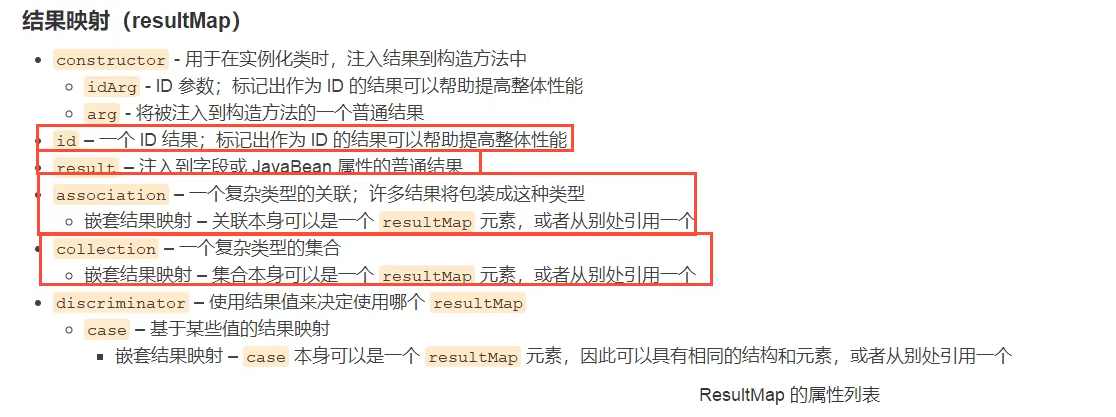
动态sql
动态sql:根据不同的条件生成不同的SQL语句
1. 搭建环境
create table `blog`(
`id` varchar(50) not null comment '博客id',
`title` varchar(100) not null comment '博客标题',
`author` varchar(30) not null comment '博客作者',
`create_time` datetime not null comment '创建时间',
`views` int(30) not null comment '浏览量'
)ENGINE=InnoDB DEFAULT CHARSET=utf8
实体类
package com.hou.pojo;
import lombok.Data;
import java.util.Date;
@Data
public class Blog {
private String id;
private String title;
private String author;
private Date createTime;
private int views;
}
核心配置
<settings>
<setting name="mapUnderscoreToCamelCase" value="true"/>
</settings>
Mapper.xml
<?xml version="1.0" encoding="UTF-8" ?>
<!DOCTYPE mapper
PUBLIC "-//mybatis.org//DTD Config 3.0//EN"
"http://mybatis.org/dtd/mybatis-3-mapper.dtd">
<mapper namespace="com.hou.mapper.BlogMapper">
<insert id="addBlog" parameterType="Blog">
insert into mybatis.blog (id, title, author, create_time, views) values
(#{id}, #{title}, #{author}, #{create_time}, #{views});
</insert>
</mapper>
新建随机生成ID包
package com.hou.utils;
import org.junit.Test;
import java.util.UUID;
@SuppressWarnings("all")
public class IDUtiles {
public static String getId(){
return UUID.randomUUID().toString().replaceAll("-","");
}
@Test
public void test(){
System.out.println(getId());
}
}
测试类:添加数据
import com.hou.mapper.BlogMapper;
import com.hou.pojo.Blog;
import com.hou.utils.IDUtiles;
import com.hou.utils.MybatisUtils;
import org.apache.ibatis.session.SqlSession;
import org.junit.Test;
import java.util.Date;
public class MyTest {
@Test
public void addBlog(){
SqlSession sqlSession = MybatisUtils.getSqlSession();
BlogMapper blogMapper = sqlSession.getMapper(BlogMapper.class);
Blog blog = new Blog();
blog.setId(IDUtiles.getId());
blog.setAuthor("houdongun");
blog.setCreateTime(new Date());
blog.setViews(999);
blog.setTitle("first");
blogMapper.addBlog(blog);
blog.setId(IDUtiles.getId());
blog.setTitle("second");
blogMapper.addBlog(blog);
blog.setId(IDUtiles.getId());
blog.setTitle("third");
blogMapper.addBlog(blog);
blog.setId(IDUtiles.getId());
blog.setTitle("forth");
blogMapper.addBlog(blog);
sqlSession.close();
}
}
2. if
<select id="queryBlogIF" parameterType="map" resultType="Blog">
select * from mybatis.blog where 1=1
<if test="title != null">
and title = #{title}
</if>
<if test="author != author">
and author = #{author}
</if>
</select>
test
@Test
public void queryBlogIF(){
SqlSession sqlSession = MybatisUtils.getSqlSession();
BlogMapper blogMapper = sqlSession.getMapper(BlogMapper.class);
Map map = new HashMap();
// map.put("title", "second");
map.put("author", "houdongun");
List<Blog> list = blogMapper.queryBlogIF(map);
for (Blog blog : list) {
System.out.println(blog);
}
sqlSession.close();
}
3. choose、when、otherwise
<select id="queryBlogchoose" parameterType="map" resultType="Blog">
select * from mybatis.blog
<where>
<choose>
<when test="title != null">
title = #{title}
</when>
<when test="author != null">
and author = #{author}
</when>
<otherwise>
and views = #{views}
</otherwise>
</choose>
</where>
</select>
4. trim、where、set
<update id="updateBlog" parameterType="map">
update mybatis.blog
<set>
<if test="title != null">
title = #{title},
</if>
<if test="author != null">
author = #{author}
</if>
</set>
where id = #{id}
</update>
trim 可以自定义
SQL片段
有些时候我们有一些公共部分
- 使用sql便签抽取公共部分
- 在使用的地方使用include标签
<sql id="if-title-author">
<if test="title != null">
title = #{title}
</if>
<if test="author != null">
and author = #{author}
</if>
</sql>
<select id="queryBlogIF" parameterType="map" resultType="Blog">
select * from mybatis.blog
<where>
<include refid="if-title-author"></include>
</where>
</select>
注意:
- 最好基于单表
- sql里不要存在where标签
5. for-each
<!--ids是传的,#{id}是遍历的-->
<select id="queryBlogForeach" parameterType="map" resultType="Blog">
select * from mybatis.blog
<where>
<foreach collection="ids" item="id" open="and ("
close=")" separator="or">
id=#{id}
</foreach>
</where>
</select>
test
@Test
public void queryBlogForeach(){
SqlSession sqlSession = MybatisUtils.getSqlSession();
BlogMapper blogMapper = sqlSession.getMapper(BlogMapper.class);
Map map = new HashMap();
ArrayList<Integer> ids = new ArrayList<Integer>();
ids.add(1);
ids.add(3);
map.put("ids",ids);
List<Blog> list = blogMapper.queryBlogForeach(map);
for (Blog blog : list) {
System.out.println(blog);
}
sqlSession.close();
}
缓存(了解)
1. 一级缓存
- 开启日志
- 测试一个session中查询两次相同记录。
缓存失效:
- 映射语句文件中的所有 insert、update 和 delete 语句会刷新缓存。
- 查询不同的mapper.xml
- 手动清除缓存
一级缓存默认开启,只在一次sqlseesion中有效
2. 二级缓存
- 开启全局缓存
<setting name="cacheEnabled" value="true"/>
- 在当前mapper.xml中使用二级缓存
<cache eviction="FIFO"
flushInterval="60000"
size="512"
readOnly="true"/>
test
@Test
public void test(){
SqlSession sqlSession = MybatisUtils.getSqlSession();
SqlSession sqlSession1 = MybatisUtils.getSqlSession();
UserMapper userMapper = sqlSession.getMapper(UserMapper.class);
User user = userMapper.queryUserByid(1);
System.out.println(user);
sqlSession.close();
UserMapper userMapper1 = sqlSession1.getMapper(UserMapper.class);
User user1 = userMapper1.queryUserByid(1);
System.out.println(user1);
System.out.println(user==user1);
sqlSession1.close();
}
只用cache时加序列化
<cache/>
实体类
package com.hou.pojo;
import lombok.Data;
import java.io.Serializable;
@Data
public class User implements Serializable {
private int id;
private String name;
private String pwd;
public User(int id, String name, String pwd) {
this.id = id;
this.name = name;
this.pwd = pwd;
}
}
小结:
- 只有开启了二级缓存,在Mapper下有效
- 所有数据都会先放在一级缓存
- 只有当回话提交,或者关闭的时候,才会提交到二级缓存
3. 自定义缓存-ehcache
<!-- https://mvnrepository.com/artifact/org.mybatis.caches/mybatis-ehcache -->
<dependency>
<groupId>org.mybatis.caches</groupId>
<artifactId>mybatis-ehcache</artifactId>
<version>1.2.0</version>
</dependency>
ehcache.xml
<?xml version="1.0" encoding="UTF-8"?>
<ehcache xmlns:xsi="http://www.w3.org/2001/XMLSchema-instance"
xsi:noNamespaceSchemaLocation="http://ehcache.org/ehcache.xsd"
updateCheck="false">
<!--
diskStore:为缓存路径,ehcache分为内存和磁盘两级,此属性定义磁盘的缓存位置。参数解释如下:
user.home – 用户主目录
user.dir – 用户当前工作目录
java.io.tmpdir – 默认临时文件路径
-->
<diskStore path="java.io.tmpdir/Tmp_EhCache"/>
<!--
defaultCache:默认缓存策略,当ehcache找不到定义的缓存时,则使用这个缓存策略。只能定义一个。
-->
<!--
name:缓存名称。
maxElementsInMemory:缓存最大数目
maxElementsOnDisk:硬盘最大缓存个数。
eternal:对象是否永久有效,一但设置了,timeout将不起作用。
overflowToDisk:是否保存到磁盘,当系统当机时
timeToIdleSeconds:设置对象在失效前的允许闲置时间(单位:秒)。仅当eternal=false对象不是永久有效时使用,可选属性,默认值是0,也就是可闲置时间无穷大。
timeToLiveSeconds:设置对象在失效前允许存活时间(单位:秒)。最大时间介于创建时间和失效时间之间。仅当eternal=false对象不是永久有效时使用,默认是0.,也就是对象存活时间无穷大。
diskPersistent:是否缓存虚拟机重启期数据 Whether the disk store persists between restarts of the Virtual Machine. The default value is false.
diskSpoolBufferSizeMB:这个参数设置DiskStore(磁盘缓存)的缓存区大小。默认是30MB。每个Cache都应该有自己的一个缓冲区。
diskExpiryThreadIntervalSeconds:磁盘失效线程运行时间间隔,默认是120秒。
memoryStoreEvictionPolicy:当达到maxElementsInMemory限制时,Ehcache将会根据指定的策略去清理内存。默认策略是LRU(最近最少使用)。你可以设置为FIFO(先进先出)或是LFU(较少使用)。
clearOnFlush:内存数量最大时是否清除。
memoryStoreEvictionPolicy:可选策略有:LRU(最近最少使用,默认策略)、FIFO(先进先出)、LFU(最少访问次数)。
FIFO,first in first out,这个是大家最熟的,先进先出。
LFU, Less Frequently Used,就是上面例子中使用的策略,直白一点就是讲一直以来最少被使用的。如上面所讲,缓存的元素有一个hit属性,hit值最小的将会被清出缓存。
LRU,Least Recently Used,最近最少使用的,缓存的元素有一个时间戳,当缓存容量满了,而又需要腾出地方来缓存新的元素的时候,那么现有缓存元素中时间戳离当前时间最远的元素将被清出缓存。
-->
<defaultCache
eternal="false"
maxElementsInMemory="10000"
overflowToDisk="false"
diskPersistent="false"
timeToIdleSeconds="1800"
timeToLiveSeconds="259200"
memoryStoreEvictionPolicy="LRU"/>
<cache
name="cloud_user"
eternal="false"
maxElementsInMemory="5000"
overflowToDisk="false"
diskPersistent="false"
timeToIdleSeconds="1800"
timeToLiveSeconds="1800"
memoryStoreEvictionPolicy="LRU"/>
</ehcache>



 浙公网安备 33010602011771号
浙公网安备 33010602011771号